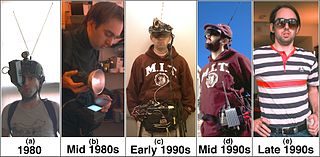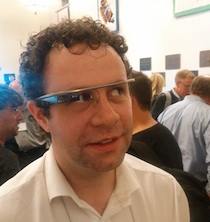Related Research Articles

The Defense Advanced Research Projects Agency (DARPA) is a research and development agency of the United States Department of Defense responsible for the development of emerging technologies for use by the military. Originally known as the Advanced Research Projects Agency (ARPA), the agency was created on February 7, 1958, by President Dwight D. Eisenhower in response to the Soviet launching of Sputnik 1 in 1957. By collaborating with academia, industry, and government partners, DARPA formulates and executes research and development projects to expand the frontiers of technology and science, often beyond immediate U.S. military requirements. The name of the organization first changed from its founding name, ARPA, to DARPA, in March 1972, changing back to ARPA in February 1993, then reverted to DARPA in March 1996.

A wearable computer, also known as a body-borne computer, is a computing device worn on the body. The definition of 'wearable computer' may be narrow or broad, extending to smartphones or even ordinary wristwatches.

Augmented reality (AR) is an interactive experience that combines the real world and computer-generated 3D content. The content can span multiple sensory modalities, including visual, auditory, haptic, somatosensory and olfactory. AR can be defined as a system that incorporates three basic features: a combination of real and virtual worlds, real-time interaction, and accurate 3D registration of virtual and real objects. The overlaid sensory information can be constructive, or destructive. As such, it is one of the key technologies in the reality-virtuality continuum.

Surveillance is the monitoring of behavior, many activities, or information for the purpose of information gathering, influencing, managing, or directing. This can include observation from a distance by means of electronic equipment, such as closed-circuit television (CCTV), or interception of electronically transmitted information like Internet traffic. Increasingly, governments may also obtain consumer data through the purchase of online information, effectively expanding surveillance capabilities through commercially available digital records. It can also include simple technical methods, such as human intelligence gathering and postal interception.

The Information Awareness Office (IAO) was established by the United States Defense Advanced Research Projects Agency (DARPA) in January 2002 to bring together several DARPA projects focused on applying surveillance and information technology to track and monitor terrorists and other asymmetric threats to U.S. national security by achieving "Total Information Awareness" (TIA).

Total Information Awareness (TIA) was a mass detection program by the United States Information Awareness Office. It operated under this title from February to May 2003 before being renamed Terrorism Information Awareness.
Combat Zones That See, or CTS, is a project of the United States Defense Advanced Research Projects Agency (DARPA) whose goal is to "track everything that moves" in a city by linking up a massive network of surveillance cameras to a centralized computer system. Artificial intelligence software will then identify and track all vehicle movement throughout the city.
Context awareness refers, in information and communication technologies, to a capability to take into account the situation of entities, which may be users or devices, but are not limited to those. Location is only the most obvious element of this situation. Narrowly defined for mobile devices, context awareness does thus generalize location awareness. Whereas location may determine how certain processes around a contributing device operate, context may be applied more flexibly with mobile users, especially with users of smart phones. Context awareness originated as a term from ubiquitous computing or as so-called pervasive computing which sought to deal with linking changes in the environment with computer systems, which are otherwise static. The term has also been applied to business theory in relation to contextual application design and business process management issues.
Messaging Application Programming Interface (MAPI) is an API for Microsoft Windows which allows programs to become email-aware. While MAPI is designed to be independent of the protocol, it is usually used to communicate with Microsoft Exchange Server.
Carnivore, later renamed DCS1000, was a system implemented by the Federal Bureau of Investigation (FBI) that was designed to monitor email and electronic communications. It used a customizable packet sniffer that could monitor all of a target user's Internet traffic. Carnivore was implemented in October 1997. By 2005 it had been replaced with improved commercial software.
Email marketing is the act of sending a commercial message, typically to a group of people, using email. In its broadest sense, every email sent to a potential or current customer could be considered email marketing. It involves using email to send advertisements, request business, or solicit sales or donations. The term usually refers to sending email messages with the purpose of enhancing a merchant's relationship with current or previous customers, encouraging customer loyalty and repeat business, acquiring new customers or convincing current customers to purchase something immediately, and sharing third-party ads.

Digital signage is a segment of electronic signage. Digital displays use technologies such as LCD, LED, OLED, projection and e-paper to display digital images, video, web pages, weather data, restaurant menus, or text. They can be found in public spaces, transportation systems, museums, stadiums, retail stores, hotels, restaurants and corporate buildings etc., to provide wayfinding, exhibitions, marketing and outdoor advertising. They are used as a network of electronic displays that are centrally managed and individually addressable for the display of text, animated or video messages for advertising, information, entertainment and merchandising to targeted audiences.

Fedora is a digital asset management (DAM) content repository architecture upon which institutional repositories, digital archives, and digital library systems might be built. Fedora is the underlying architecture for a digital repository, and is not a complete management, indexing, discovery, and delivery application. It is a modular architecture built on the principle that interoperability and extensibility are best achieved by the integration of data, interfaces, and mechanisms as clearly defined modules.
A challenge–response system is a type of that automatically sends a reply with a challenge to the (alleged) sender of an incoming e-mail. It was originally designed in 1997 by Stan Weatherby, and was called Email Verification. In this reply, the purported sender is asked to perform some action to assure delivery of the original message, which would otherwise not be delivered. The action to perform typically takes relatively little effort to do once, but great effort to perform in large numbers. This effectively filters out spammers. Challenge–response systems only need to send challenges to unknown senders. Senders that have previously performed the challenging action, or who have previously been sent e-mail(s) to, would be automatically receive a challenge.

A lifelog is a personal record of one's daily life in a varying amount of detail, for a variety of purposes. The record contains a comprehensive dataset of a human's activities. The data could be used to increase knowledge about how people live their lives. In recent years, some lifelog data has been automatically captured by wearable technology or mobile devices. People who keep lifelogs about themselves are known as lifeloggers.
User provisioning software is software intended to help organizations more quickly, cheaply, reliably and securely manage information about users on multiple systems and applications.
Spatial contextual awareness consociates contextual information such as an individual's or sensor's location, activity, the time of day, and proximity to other people or objects and devices. It is also defined as the relationship between and synthesis of information garnered from the spatial environment, a cognitive agent, and a cartographic map. The spatial environment is the physical space in which the orientation or wayfinding task is to be conducted; the cognitive agent is the person or entity charged with completing a task; and the map is the representation of the environment which is used as a tool to complete the task.

Cathal Gurrin is an Irish Professor and lifelogger. He is the Head of the Adapt Centre at Dublin City University, a Funded Investigator of the Insight Centre, and the director of the Human Media Archives research group. He was previously the deputy head of the School of Computing.

Swarm by Foursquare is a mobile app that allows users to share their locations with their friends and create a record of their experiences in a personal lifelog. Swarm launched for iOS and Android devices on May 15, 2014. A spin-off from and companion app to Foursquare City Guide, Swarm allows users to check-in to a given location, and see who is nearby. These check-ins are chronologically listed to create a personal lifelog for each user, which serves as a digital library for all the places they have been, in a searchable database that can be revisited and shared.
The Internet of Military Things (IoMT) is a class of Internet of things for combat operations and warfare. It is a complex network of interconnected entities, or "things", in the military domain that continually communicate with each other to coordinate, learn, and interact with the physical environment to accomplish a broad range of activities in a more efficient and informed manner. The concept of IoMT is largely driven by the idea that future military battles will be dominated by machine intelligence and cyber warfare and will likely take place in urban environments. By creating a miniature ecosystem of smart technology capable of distilling sensory information and autonomously governing multiple tasks at once, the IoMT is conceptually designed to offload much of the physical and mental burden that warfighters encounter in a combat setting.
References
- ↑ "Pentagon Explores a New Frontier In the World of Virtual Intelligence". The New York Times . May 30, 2003. Retrieved 19 December 2013.
- 1 2 PIP 03-30 Archived June 3, 2003, at the Wayback Machine , DARPA's bid solicitation for LifeLog (now offline) at the Internet Archive
- ↑ Pedersen, Isabel (2013). Ready to Wear: A Rhetoric of Wearable Computers and Reality-Shifting Media. Anderson: Parlor Press. p. 111. ISBN 978-1602354005.
- 1 2 "Your life at your fingertips — courtesy of the Pentagon". USA Today . 2 June 2003. Retrieved 20 December 2013.
- ↑ "Pentagon Kills LifeLog Project". Wired. 4 February 2004.
- ↑ "15 Years Ago, the Military Tried to Record Whole Human Lives. Badly". www.vice.com. 21 May 2018. Retrieved 2020-08-01.